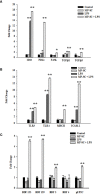In "Vitro" Lps-Stimulated Sertoli Cells Pre-Loaded With Microparticles: Intracellular Activation Pathways
- PMID: 33488524
- PMCID: PMC7817811
- DOI: 10.3389/fendo.2020.611932
In "Vitro" Lps-Stimulated Sertoli Cells Pre-Loaded With Microparticles: Intracellular Activation Pathways
Abstract
Sertoli cells (SC) are immune privileged cells with the capacity of modulating the immune response by expressing several immune-regulatory factors. SC have the capacity to respond to external stimuli through innate phagocytic and antibacterial activities. This evidence evoked a potential role of SC as drug carriers and therapeutic agents. Such stimuli drive SC towards a still unknown evolution, the clinical relevance of which as yet remains undisclosed. This study sought to investigate the effects of external stimuli in the form of polymeric microparticles (MP) and bacteria derived endotoxins, such as lipopolysaccharides (LPS), in order to identify the pathways potentially involved in cell phenotype modifications. Compared to single stimulation, when combined, MP and LPS provoked a significant increase in the gene expression of IDO, PD-L1, FAS-L, TLR-3, TLR-4, MHC-II, ICAM-1, TFGβ1, BDF123, BDF129, BDF3 and pEP2C. Western Blotting analysis demonstrated up-regulation of the ERK 1-2 and NF-kB p65 phosphorylation ratios. Our study, showing the exponential increase of these mediators upon combined MP and LPS stimulation, suggests a "switch" of SC function from typical cells of the blood-testicular barrier to nonprofessional tolerogenic antigen-presenting cells. Further studies should target the clinical and technological implications of such stimuli-induced SC transformation.
Keywords: Sertoli cells; lipopolysaccharide; microparticles; nonprofessional tolerogenic; pro-inflammatory pathways.
Copyright © 2021 Arato, Milardi, Giovagnoli, Grande, Bellucci, Lilli, Bartoli, Corneli, Mazzone, Calvitti, Baroni, Calafiore, Mancuso and Luca.
Conflict of interest statement
The authors declare that the research was conducted in the absence of any commercial or financial relationships that could be construed as a potential conflict of interest.
Figures



Similar articles
-
Exploring Sertoli Cells' Innate Bulwark Role Against Infections: In Vitro Performances on Candida tropicalis Biofilms.Cells. 2025 Mar 26;14(7):495. doi: 10.3390/cells14070495. Cells. 2025. PMID: 40214449 Free PMC article.
-
Caffeine suppresses lipopolysaccharide-stimulated BV2 microglial cells by suppressing Akt-mediated NF-κB activation and ERK phosphorylation.Food Chem Toxicol. 2012 Dec;50(12):4270-6. doi: 10.1016/j.fct.2012.08.041. Epub 2012 Sep 10. Food Chem Toxicol. 2012. PMID: 22974838
-
Anti-inflammatory potential of β-cryptoxanthin against LPS-induced inflammation in mouse Sertoli cells.Reprod Toxicol. 2016 Apr;60:148-55. doi: 10.1016/j.reprotox.2015.11.003. Epub 2015 Dec 10. Reprod Toxicol. 2016. PMID: 26686910
-
Docosahexaenoic acid attenuates LPS-stimulated inflammatory response by regulating the PPARγ/NF-κB pathways in primary bovine mammary epithelial cells.Res Vet Sci. 2017 Jun;112:7-12. doi: 10.1016/j.rvsc.2016.12.011. Epub 2017 Jan 5. Res Vet Sci. 2017. PMID: 28095338 Review.
-
The role of the Fas/FasL signaling pathway in environmental toxicant-induced testicular cell apoptosis: An update.Syst Biol Reprod Med. 2018 Apr;64(2):93-102. doi: 10.1080/19396368.2017.1422046. Epub 2018 Jan 4. Syst Biol Reprod Med. 2018. PMID: 29299971 Review.
Cited by
-
Strategies and delivery systems for cell-based therapy in autoimmunity.Front Drug Deliv. 2024 Aug 8;4:1436842. doi: 10.3389/fddev.2024.1436842. eCollection 2024. Front Drug Deliv. 2024. PMID: 40836971 Free PMC article. Review.
-
IL20RA Is the Key Factor Contributing to the Stronger Antioxidant Capacity of Rongchang Pig Sertoli Cells.Antioxidants (Basel). 2024 Dec 17;13(12):1545. doi: 10.3390/antiox13121545. Antioxidants (Basel). 2024. PMID: 39765872 Free PMC article.
-
Effects of Titanium Dioxide Nanoparticles on Porcine Prepubertal Sertoli Cells: An "In Vitro" Study.Front Endocrinol (Lausanne). 2022 Jan 3;12:751915. doi: 10.3389/fendo.2021.751915. eCollection 2021. Front Endocrinol (Lausanne). 2022. PMID: 35046890 Free PMC article.
-
Effects and Mechanisms Activated by Treatment with Cationic, Anionic and Zwitterionic Liposomes on an In Vitro Model of Porcine Pre-Pubertal Sertoli Cells.Int J Mol Sci. 2023 Jan 7;24(2):1201. doi: 10.3390/ijms24021201. Int J Mol Sci. 2023. PMID: 36674712 Free PMC article.
-
Exploring Sertoli Cells' Innate Bulwark Role Against Infections: In Vitro Performances on Candida tropicalis Biofilms.Cells. 2025 Mar 26;14(7):495. doi: 10.3390/cells14070495. Cells. 2025. PMID: 40214449 Free PMC article.
References
-
- Skinner MK, Griswold MD. eds. Sertoli Cell Biology Vol. 1 San Diego, CA, USA: Elsevier Academic Press; (2005).
-
- Griswold MD. Protein secretion by Sertoli cells: general considerations. In: Russell LD, Griswold MD, editors. The Sertoli Cell. Clearwater, FL: Cache River Press; (1993). p. 195–200.
MeSH terms
Substances
LinkOut - more resources
Full Text Sources
Other Literature Sources
Research Materials
Miscellaneous

